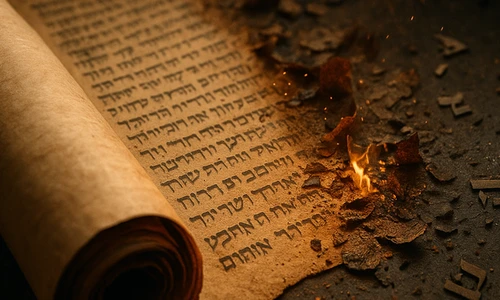12 Tribes of Israel: Every Biblical List in One Chart
The Bible names Israel’s tribes at least 19 times, from Genesis 30 to Revelation 7. Because Joseph’s sons replace him and Levi is set apart for priests, lists range from eleven to fourteen names and appear in shifting orders.
Despite all this shifting, 9 of the 19—almost half—still manage to list exactly twelve tribes. How do they get there?
- Before Israel goes down to Egypt, Ephraim and Manasseh (Joseph’s sons, born in Egypt) are not listed.
- Levi is left off whenever the focus is land, war, or the census (priests are kept separate, and they live in scattered cities instead of dedicated land).
- Sometimes Joseph is replaced with his two sons, especially when Levi is dropped—Joseph’s double portion of the inheritance keeps the count at twelve.
- In Revelation, when Dan is left off (see below), Joseph is included because he’s on of Jacob’s sons, and then Manasseh is added, allowing John to stay at twelve without leaving Joseph out.
📥 Download high-resolution image | 👇 Get the full Tribes Toolkit
You’d think this would be an easy question to answer, given the Bible’s obsession not only with the tribes but with the number twelve. But it turns out it’s not always as easy as you’d hope.
The twelve tribes are named at least nineteen times in Scripture. Here are some of the significant ones:
- When the patriarchs of the tribes are born (Genesis 30, except Benjamin, who isn’t born until Genesis 35)
- When Jacob blesses his sons (Genesis 49)
- When Moses blesses the tribes (Deuteronomy 33)
- When Ezekiel sees the gates of the city (Ezekiel 48)
- When John lists the twelve thousand sealed from each tribe (Revelation 7)
These lists are, incredibly, not consistent in order or in number.
Five Patterns to Notice
- Leah’s six sons are almost always clustered together right up until Revelation (although not always in the same order), even though Issachar and Zebulun are far down the birth order.
- East-bank tribes (Reuben, Gad, half-Manasseh) vanish from later territorial lists.
- Camp sides connect to tons of other four-sided things in Scripture. Here’s a freebie to get you started: Judah, the lion, camps on the east (click the Camp side table header to see who camps with him). Now go read Ezekiel 1.
- Moses’s blessing is pretty out-of-order: he’s clearly considering God’s plan, not human birth order
- Twelve shows up again and again in Scripture; it’s not an accident that Jesus called twelve disciples.
Tribes of Israel Interactive Table
| Tribe | Birth Order | Mother | Camp side | Land allocation | Notes |
|---|---|---|---|---|---|
| Reuben | 1 | Leah | South | East Jordan (north of Arnon) | — |
| Simeon | 2 | Leah | South | Enclaves inside Judah | Absorbed by Judah |
| Levi | 3 | Leah | Center | 48 priestly cities | No tribal land |
| Judah | 4 | Leah | East | Judean hills | Royal line |
| Dan | 5 | Bilhah | North | Coastal plain → Laish (north) | Migrated north |
| Naphtali | 6 | Bilhah | North | Upper Galilee | — |
| Gad | 7 | Zilpah | South | East Jordan (Gilead) | Pastoral |
| Asher | 8 | Zilpah | North | Coastal Galilee | — |
| Issachar | 9 | Leah | East | Jezreel Valley | — |
| Zebulun | 10 | Leah | East | Lower Galilee | — |
| Joseph | 11 | Rachel | — | Split: Ephraim & Manasseh | Double-portion due to two sons |
| Benjamin | 12 | Rachel | West | Benjamin plateau | — |
| Ephraim | 13 | Rachel (via Joseph) | West | Central hill country | Joseph’s son |
| Manasseh | 14 | Rachel (via Joseph) | Split: West/East | Split: Samaria & Bashan | Joseph’s son |
Why Aren’t All the Lists the Same? What Happened?
Well, to start, Jacob has exactly twelve sons: Reuben, Simeon, Levi, Judah, Dan, Naphtali, Gad, Asher, Issachar, Zebulun, Joseph, and Benjamin.
He also has at least one daughter, named Dinah (Genesis 30:21), and probably many more.
After Joseph’s brothers sell him into slavery in Egypt, he has two sons: Ephraim and Manasseh. When Jacob and his family come to Egypt to escape the famine, Jacob adopts Joseph’s sons as his own, bringing the total to fourteen.
God sets apart the tribe of Levi for the priesthood, so Levi is left off of the lists of censuses (Numbers 1, 26), offerings (Numbers 7), camp arrangements (Numbers 2), marching orders (Numbers 10), spies (Numbers 13), and land grants (Numbers 34) throughout Israel’s wanderings in the wilderness.
Just before they finish their journey, Reuben, Gad, and half the tribe of Manasseh elect to stay outside the Promised Land, on the other side of the Jordan, because their flocks and herds are so large. (Moses only permits them after they promise to provide military support to the tribes that do cross the river.) Therefore, Reuben and Gad are also left off the land grant.
So far, so good, but then it gets weird.
When Moses blesses the tribes, he includes Joseph and both of his sons, but leaves off Simeon. When David takes his unwise census of Israel, Gad is excluded.
Ezekiel’s vision of the city of God includes Jacob’s original sons, but John’s vision of the same thing, hundreds of years later, adds Manasseh and leaves off Dan.
📜 Where did Dan go?
Judges 18 tells how the Danites abandoned their coastal territory—overrun by Philistines—and migrated north to capture Laish, renaming it “Dan.” The tribe later became a center of idolatry under Jeroboam’s golden-calf cult (1 Kings 12:30). Many scholars think John’s Revelation 7 omits Dan to symbolize judgment on persistent idolatry, echoing Leviticus 24:11 where a half-Danite blasphemes God’s name.
Finally, of the nineteen lists of the tribes of Israel in the Bible, only three have the exact same order: the arrangement of the camp around the tabernacle in the wilderness; the order of first offerings at the tabernacle; and the marching order when the nation moves.
All of the rest are different.
Why do you think the orders are different? What happened to Simeon, Gad, and Dan? If you think you know, please get in touch.
Reflection Questions
- Which counting rule (drop Levi vs. split Joseph) best reflects your own instinct about leadership and inheritance? How would you list the tribes?
- What might Dan’s omission teach modern believers about legacy and faithfulness?
- Twelve keeps reappearing in Scripture—from Jacob’s sons to Jesus’ disciples. Where else have you noticed God using symbolic numbers or patterns, and how might that deepen your trust that He is weaving a coherent story?




